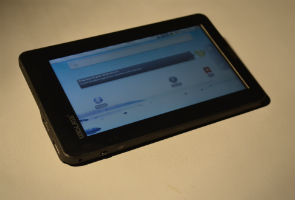- Home
- Tablets
- Tablets News
- $50 tablet: From prototype to reality
$50 tablet: From prototype to reality
By Sameer Mitha, NDTV | Updated: 6 June 2012 15:24 IST

Click Here to Add Gadgets360 As A Trusted Source

Advertisement
It was exactly a year ago that we aired a Gadget Guru special and showed you what Kapil Sibal's then priced at $35 tablet looked like. It was at prototype stage and Mr. Sibal was reluctant to let the device out of his sight for even a second, but the concept of the device was revolutionary. Today, we have the exclusive opportunity to see the "finished product". The one that will be available to consumers all over India and we have to tell you, we are a bit impressed.
As the story of this tablet drifted from a dream to myth and even legend that would soon be forgotten, the HRD ministry sprang back with a device which, though no iPad killer, can surely reach out to the masses making the tablet as popular as the mobile phone to a nation of a billion+ people.
Putting myth against reality, here are some of the features of the prototype we saw compared to the final product.
The prototype was honestly a "too good to be true" device when we laid our hands on it. It had a camera, Wi-Fi, a resistive touchscreen with a stylus, Android 2.1OS and physical control buttons. In terms of connectivity, it supported flash storage, SIM card slot, a full USB port, mini USB port and a video out. The overall feel of the device was that it was thick and had a rubberized texture to it.
All that has effectively changed in the final version of the device. Apart from the rubberized finish, you'd think the device was redesigned from the ground up. The final unit has lost all the connectivity options its prototype counterpart offered. The only similarity is the 7-inch resistive touchscreen. There is just one face button, which is essentially the home button. That's it. No menu, volume rocker or back button. Press and hold the home button and you have the menu option. In terms of connectivity, the device has support for two full sized USB ports and a micro SD card slot along with a headphone jack and the DC in port. The only similarity is the OS. The prototype ran on android 2.1 and the final version runs on 2.2. The video out has been removed. We were given no under the hood hardware specs for the prototype we do have them for the final build. It has a 366MHz processor with a dedicated HD video processor and 2GB on board flash storage. The device has the capability to play full HD videos at 1080p. We saw a few HD YouTube videos on the device and they ran absolutely smoothly, without any hiccups. The battery on the other hand is a bit underwhelming. The ministry claims that at 2100mAh, the device will last for about 1.5 to 2 hours if used to watch videos. If used averagely, the device will last for about 3 hours. That's a short span as the device wouldn't last an entire school day and students will need to visit a charging station every two hours.
In terms of its overall build and form factor, the device felt a lot lighter while still maintaining a rubberized finish to it.
Obviously the most important question in our minds is "Has the device lived up to the $35 price tag?" Technically, it hasn't. The HRD ministry has informed us that the manufacturing cost of the device is $37.98. The sales price of the device however is $49.98 after adding the transportation cost, warranty and other costs. The manufacturer will be able to deliver 1,00,000 units of the device to consumers at $49.98 that is approximately Rs. 2276. So the $35 claim does not hold true in real terms. From what we've seen, however, this device sure has the potential to give the LACS $99 tablet a run for its money!
So, if $37.98 is the cost of the device, what will the institutes have to pay? How much is the government going to subsidize the device? The answer is 50%. An institute that wishes to make this tablet available to its student will pay Rs. 1500 or less, the ministry has informed us.
In terms of educational apps, it seems the ecosystem has been in place since 2003 when the NPTEL (National Programme of Technology Enabled Learning) was put into place. All the video lectures along with animations, simulations, notes and tests are available to students free of cost at http://nptel.iitm.ac.in/ A disadvantage is that the tablet doesn't support the Android Market place straight out of the box. Instead, the tablet will run the GetJar app store.
Even at a shade under $50 the tablet is a snip. But can it be sustained?
Since tablet maker Datawind has taken up the challenge to make the "Made in India" tag possible, is it a viable business opportunity? According to the CEO of Datawind, Suneet Singh Tuli, it is profitable. In fact, it is so profitable that he has decided to throw in a GPRS receiver and a SIM card slot into the device without any extra charge to the government. He will still maintain the price point of $37.98. These add-ons are not in the first lot of 10,000 units as they have already been delivered to the Ministry. But the rest of the 90,000 units will have these add ons.
The biggest question however remains as to how the company managed to maintain a manufacturing cost of $37.98? The answer is assembling everything your self. The most expensive component on the device, according to Suneet Singh Tuli, is the screen and he has managed to keep the cost under $10. He has admitted, however, that it would have been cheaper to produce the tablet in China. When asked about the increased cost of production in India, Mr. Tuli said, "although this being an educational device there are no custom duties, however there are a lot of inter-state sales taxes, VAT and other charges that have to be paid in India to get the devices across from the manufacturing unit in Hyderabad."
Mr. Sibal and his team are optimistic that the road ahead for this device is not just confined to India and it has great potential in other developing countries. Not only that, though the device is primarily targetted at students, there is immense potential of e-governance initiatives that can be pushed through this device to large sections of the population where Internet and computers are yet to make inroads. Do you think this is the game-changing tablet the world has been waiting for? Tell us in the comments below.
As the story of this tablet drifted from a dream to myth and even legend that would soon be forgotten, the HRD ministry sprang back with a device which, though no iPad killer, can surely reach out to the masses making the tablet as popular as the mobile phone to a nation of a billion+ people.
Putting myth against reality, here are some of the features of the prototype we saw compared to the final product.
The prototype was honestly a "too good to be true" device when we laid our hands on it. It had a camera, Wi-Fi, a resistive touchscreen with a stylus, Android 2.1OS and physical control buttons. In terms of connectivity, it supported flash storage, SIM card slot, a full USB port, mini USB port and a video out. The overall feel of the device was that it was thick and had a rubberized texture to it.
All that has effectively changed in the final version of the device. Apart from the rubberized finish, you'd think the device was redesigned from the ground up. The final unit has lost all the connectivity options its prototype counterpart offered. The only similarity is the 7-inch resistive touchscreen. There is just one face button, which is essentially the home button. That's it. No menu, volume rocker or back button. Press and hold the home button and you have the menu option. In terms of connectivity, the device has support for two full sized USB ports and a micro SD card slot along with a headphone jack and the DC in port. The only similarity is the OS. The prototype ran on android 2.1 and the final version runs on 2.2. The video out has been removed. We were given no under the hood hardware specs for the prototype we do have them for the final build. It has a 366MHz processor with a dedicated HD video processor and 2GB on board flash storage. The device has the capability to play full HD videos at 1080p. We saw a few HD YouTube videos on the device and they ran absolutely smoothly, without any hiccups. The battery on the other hand is a bit underwhelming. The ministry claims that at 2100mAh, the device will last for about 1.5 to 2 hours if used to watch videos. If used averagely, the device will last for about 3 hours. That's a short span as the device wouldn't last an entire school day and students will need to visit a charging station every two hours.
In terms of its overall build and form factor, the device felt a lot lighter while still maintaining a rubberized finish to it.
Obviously the most important question in our minds is "Has the device lived up to the $35 price tag?" Technically, it hasn't. The HRD ministry has informed us that the manufacturing cost of the device is $37.98. The sales price of the device however is $49.98 after adding the transportation cost, warranty and other costs. The manufacturer will be able to deliver 1,00,000 units of the device to consumers at $49.98 that is approximately Rs. 2276. So the $35 claim does not hold true in real terms. From what we've seen, however, this device sure has the potential to give the LACS $99 tablet a run for its money!
So, if $37.98 is the cost of the device, what will the institutes have to pay? How much is the government going to subsidize the device? The answer is 50%. An institute that wishes to make this tablet available to its student will pay Rs. 1500 or less, the ministry has informed us.
In terms of educational apps, it seems the ecosystem has been in place since 2003 when the NPTEL (National Programme of Technology Enabled Learning) was put into place. All the video lectures along with animations, simulations, notes and tests are available to students free of cost at http://nptel.iitm.ac.in/ A disadvantage is that the tablet doesn't support the Android Market place straight out of the box. Instead, the tablet will run the GetJar app store.
Even at a shade under $50 the tablet is a snip. But can it be sustained?
Since tablet maker Datawind has taken up the challenge to make the "Made in India" tag possible, is it a viable business opportunity? According to the CEO of Datawind, Suneet Singh Tuli, it is profitable. In fact, it is so profitable that he has decided to throw in a GPRS receiver and a SIM card slot into the device without any extra charge to the government. He will still maintain the price point of $37.98. These add-ons are not in the first lot of 10,000 units as they have already been delivered to the Ministry. But the rest of the 90,000 units will have these add ons.
The biggest question however remains as to how the company managed to maintain a manufacturing cost of $37.98? The answer is assembling everything your self. The most expensive component on the device, according to Suneet Singh Tuli, is the screen and he has managed to keep the cost under $10. He has admitted, however, that it would have been cheaper to produce the tablet in China. When asked about the increased cost of production in India, Mr. Tuli said, "although this being an educational device there are no custom duties, however there are a lot of inter-state sales taxes, VAT and other charges that have to be paid in India to get the devices across from the manufacturing unit in Hyderabad."
Mr. Sibal and his team are optimistic that the road ahead for this device is not just confined to India and it has great potential in other developing countries. Not only that, though the device is primarily targetted at students, there is immense potential of e-governance initiatives that can be pushed through this device to large sections of the population where Internet and computers are yet to make inroads. Do you think this is the game-changing tablet the world has been waiting for? Tell us in the comments below.
Comments
Get your daily dose of tech news, reviews, and insights, in under 80 characters on Gadgets 360 Turbo. Connect with fellow tech lovers on our Forum. Follow us on X, Facebook, WhatsApp, Threads and Google News for instant updates. Catch all the action on our YouTube channel.
Related Stories
Popular on Gadgets
- Samsung Galaxy Unpacked 2025
- ChatGPT
- Redmi Note 14 Pro+
- iPhone 16
- Apple Vision Pro
- Oneplus 12
- OnePlus Nord CE 3 Lite 5G
- iPhone 13
- Xiaomi 14 Pro
- Oppo Find N3
- Tecno Spark Go (2023)
- Realme V30
- Best Phones Under 25000
- Samsung Galaxy S24 Series
- Cryptocurrency
- iQoo 12
- Samsung Galaxy S24 Ultra
- Giottus
- Samsung Galaxy Z Flip 5
- Apple 'Scary Fast'
- Housefull 5
- GoPro Hero 12 Black Review
- Invincible Season 2
- JioGlass
- HD Ready TV
- Laptop Under 50000
- Smartwatch Under 10000
- Latest Mobile Phones
- Compare Phones
Latest Gadgets
- Redmi Note 15 5G
- Redmi Note 15 Pro 5G
- Redmi Note 15 Pro+ 5G
- Lava Play Max
- Poco C85 5G
- Honor Magic 8 Lite
- Jolla Phone
- Realme P4x 5G
- Asus ProArt P16
- MacBook Pro 14-inch (M5, 2025)
- OnePlus Pad Go 2
- Poco Pad M1
- Just Corseca Skywatch Pro
- Honor Watch X5
- Acerpure Nitro Z Series 100-inch QLED TV
- Samsung 43 Inch LED Ultra HD (4K) Smart TV (UA43UE81AFULXL)
- Asus ROG Ally
- Nintendo Switch Lite
- Haier 1.6 Ton 5 Star Inverter Split AC (HSU19G-MZAID5BN-INV)
- Haier 1.6 Ton 5 Star Inverter Split AC (HSU19G-MZAIM5BN-INV)
© Copyright Red Pixels Ventures Limited 2025. All rights reserved.

















